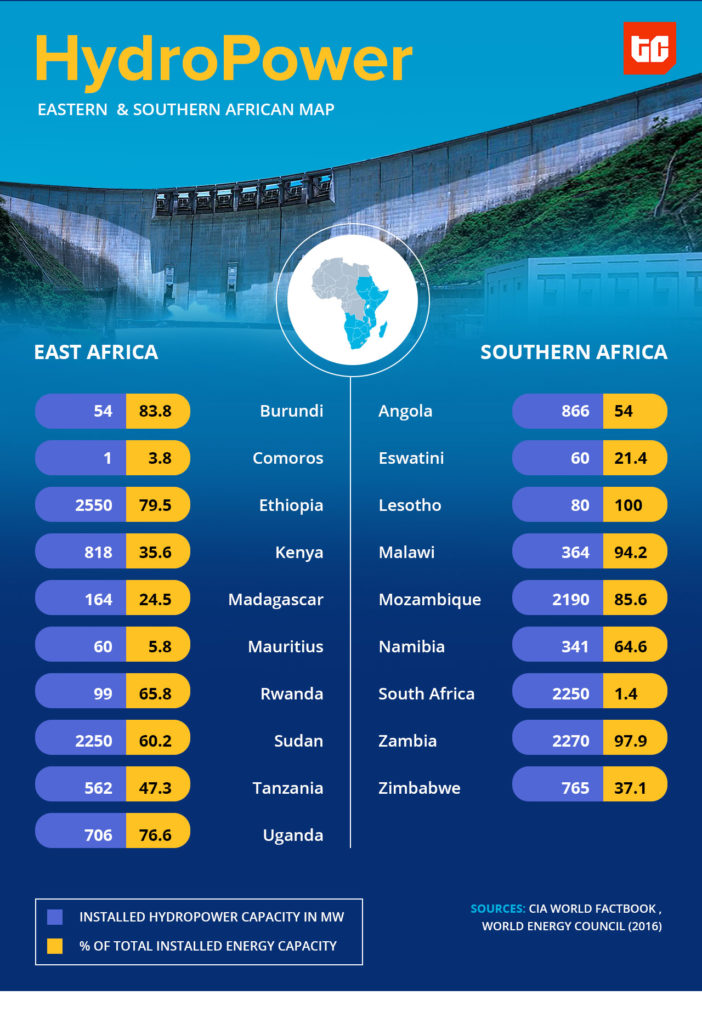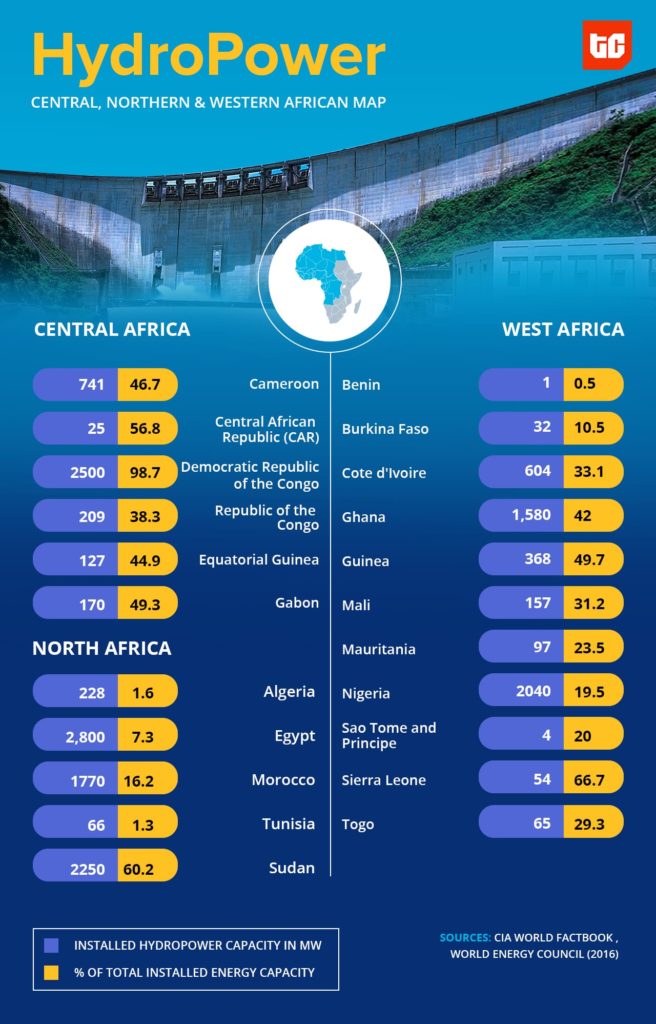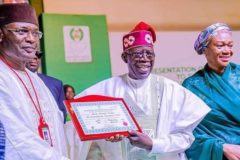Gada, a rural community in Nassarawa, North Central Nigeria, was without power for about 12 years. This was despite the presence of the River Mada in the area. It was a case of wasted potential. In 2014, government authorities, Smart Hydro System (a hydropower startup) and community members witnessed the launch of a micro hydropower system. The water turbines would provide all-year-round energy for 7 households living close to the river even in the dry season. “Thank you for unexpectedly supplying us power in our community,” Likita Danbaiki, the Community Head was translated as saying at the time. “Our thanks go to God, the boss and those who executed the project,” Likita concluded in his local dialect.
Micro-hydropower systems and large-scale grid-connected hydropower plants take the largest share in Africa’s renewable energy mix. As of 2010, hydropower represented 21% of Africa’s total installed energy capacity*. In 2013, the proportion of hydropower in the continent’s renewable energy mix was about 84%. The total installed hydropower capacity for Africa was about 35,339 MW (35GW) in 2017. There is, however, a huge potential installed hydro-energy capacity that has remained untapped. In other words, there are hydro-energy sources that have not been developed or are not being used to generate power.
Untapped Potential
Africa has a potential to have installed energy capacity of about 350,000 MW (350GW) from hydropower alone. This means that it currently has only about 10% of its hydropower capacity, some other reports put it at 20%. About half of the potential hydro-energy capacity resides in the Democratic Republic of Congo. As of 2006, small hydropower systems (SHP) had an installed capacity of 228 MW which was 0.5% of the global SHP installed capacity. For example, Nigeria had an installed SHP capacity of 33 MW and a potential of 3,500 MW.
There are a number of reasons why the potential installed hydropower capacity remains largely untapped. For one, there is limited access to funding although there’s a good amount of development financing for power projects in Africa. One instance, the African Development Bank and the World Bank made public a combined $106.5 million of funding initiatives. This was to help establish the Grand Inga Development Authority in the Democratic Republic of Congo. Another challenge is that some of the tariffs are not cost-reflective hence it remains unattractive for would-be players to get into the sector.
There’s also the question of who would buy the power once it has been generated. A number of African nations are tackling this problem by exporting their power to neighboring countries. Governments should ensure that the regulations and policy framework in their countries are transparent and fair to all. Addressing all or some of these issues will help unlock the continent’s hydropower potential. There’s however been some progress with tapping into the continent’s hydropower potential. Mambilla is set to kick off operations in Nigeria with 3,000 MW and there are plans to build a new hydropower project called the Grand Inga project (40GW) in the Democratic Republic of Congo. It will be the largest hydropower project in the world when fully developed.
Below is a list of some of the biggest producers of hydro-energy in Africa including a number of countries whose primary source of electricity comes from hydropower.
South Africa
South Africa has an installed capacity of 49,555 MW with about 6% i.e. 2,732 MW (2,250MW in 2016) of it generated from hydro-energy. The government-owned public utility company, Eskom operates about eight of the hydropower plants, the City of Cape Town operates one while the rest are operated by private companies. The Ingula Pumped Storage Scheme commissioned in 2017 has an installed capacity of 1,332 MW and is operated by Eskom. It is one of the highest generating hydro-power stations in the country.
Democratic Republic Of Congo
As of 2016, DRC had an installed hydropower capacity of 2,500 MW, the number grew to 2,542 MW in 2018. This represents about 95% of its total installed energy capacity. The country’s power supply as at 2015 was majorly supplied by two hydropower projects; Inga I (354 MW) and Inga II (1,424 MW). The Grand Inga Project (40 GW) is also in the works.
The country has the potential to produce up to 100,000 MW of hydropower due to the Congo River passing through the country. The Congo River is home to the Inga hydropower projects.
Mozambique
Mozambique had about six hydropower stations supplying its grid as at 2015. Five of the power stations are operated by the national utility while the sixth one is being managed by an independent power producer. Total installed energy capacity in 2015 was 2,556 MW with 2,188 MW (2,190 MW in 2016) of it sourced from hydro-energy. A very large amount of Mozambique’s installed hydropower comes from the 2,075 MW Cahora Bassa project located in the Zambezi Valley. About 73% of the electricity generated at the Cahora Bassa plant is exported to the Southern Africa Power Pool.
Nigeria
About 85% of Nigeria’s hydropower potential is yet to be developed, the country currently has an installed hydropower capacity of 2,380 MW (2,040 MW in 2016). A lot of its hydropower potential lies in the Niger and Benue rivers as well as Lake Chad basin. Nigeria has six hydropower stations although not all of them are fully operational. There is also the Mambilla Power project which is expected to have an installed capacity of 3,050 MW when completed.
Zambia
In Zambia, 85% of its installed energy capacity comes from hydropower representing the majority. The country has a total installed energy capacity of 2,800 MW with 2,380 MW (2,270 MW in 2016) being from hydro-energy sources. The Zambezi River is the major source of hydro-energy in Zambia. In 2015, there were challenges in the power sector due to a prolonged period of drought which led to lower water levels at the Kariba Dam. There was an estimated 300 MW drop in generational capacity owing to the drought.
Ghana
The installed hydropower capacity in Ghana is 1,580 MW out of a total installed energy capacity of 4,200 MW. There are three major hydroelectric power stations in Ghana with the highest being Akosombo Hydroelectric Power Station which has an installed capacity of 1,038 MW. Ghana is reported to have about 14 other hydropower sites asides the three already running.
Burundi
Burundi relies heavily on hydropower with an installed capacity of 54 MW. Hydropower represents about 95% of the total national generation capacity. There are six major hydropower sites in Burundi. The high dependence on hydro-energy exposes Burundi to risks of low levels of supply during drought. As an example, electricity supply dropped (PDF) by 40% during the 2009 and 2011 droughts.
Lesotho
The total installed energy capacity of Lesotho (80 MW, 2016 estimate) is 100% sourced from hydropower plants according to a 2015 estimate. The majority of the power in the country is supplied by the Muela Power Station which is a hydroelectric one.
Malawi
Malawi total installed energy capacity is gotten from renewable energy sources where hydropower stations take the larger chunk with 346 MW. The other being solar at 17 MW.
Rwanda
Although more than 7 million lack power in Rwanda, the country has achieved a 41% national electrification rate, 11% off-grid and 30% on-grid. About 50% of the country’s installed energy capacity is from hydropower (110 MW in 2018 and 99 MW in 2016) while the rest is from thermal power plants.
Uganda
According to a 2017 estimate, 77% of the installed energy capacity in Uganda is from hydropower plants. The total installed energy capacity in the country is about 958 MW with hydropower constituting 743 MW (706 MW in 2016) of it. The main and base electricity supply is generated from The Nile River is the major source of electricity supply in the country and is home to the following hydropower plants: the Bujagali plant (255 MW), the Kiira plant (200 MW) and the 180 MW Nalubaale plant. Uganda has a hydropower potential of 2,200 MW.
While hydropower takes the largest share in Africa’s renewables, its potential remains largely untapped. Addressing issues like access to funding, creating an enabling regulatory environment, among others, will unlock the remaining 80% – 90% of the continent’s hydropower potential thereby connecting millions of Africa to electricity.
*Installed energy capacity is not the same as the actual amount of the power a country is generating.
**Countries not listed on the maps do not have installed hydro-power capacity.























